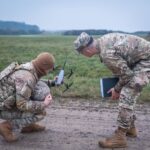
Ten months after Epirus and General Dynamics [GD] partnered to integrate a directed energy system aboard the Stryker wheeled combat vehicle, the companies on Wednesday said they have successfully demonstrated Epirus’ Leonidas counter-electronics array aboard the GD-built vehicle in disabling drones for short-range air defense. Stryker Leonidas, which went from concept in October 2021 to a successful field test in August, will be on display at the annual Association of the U.S. Army (AUSA) conference in Washington, D.C., next week.…

 By
By 











